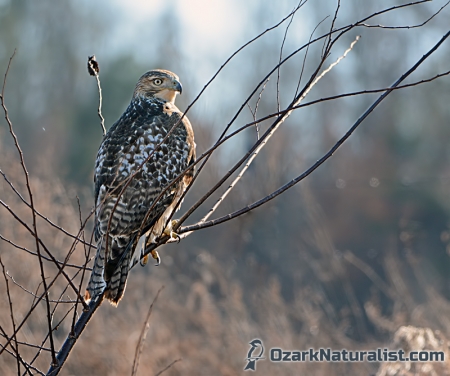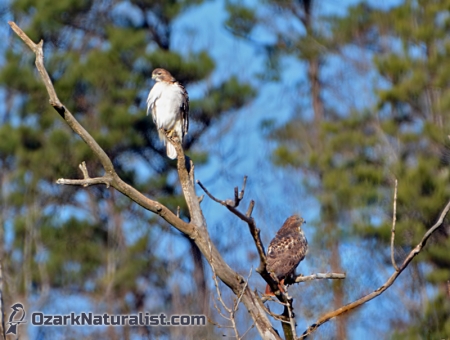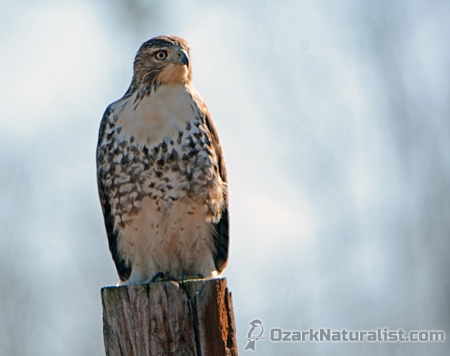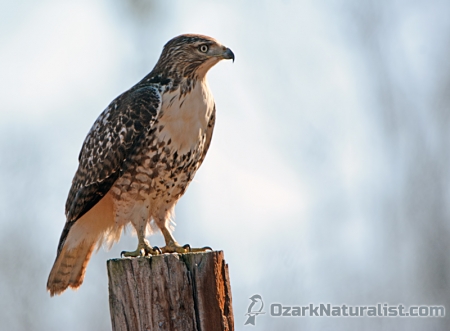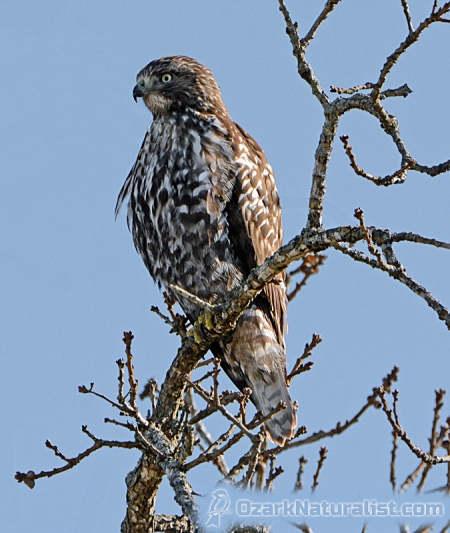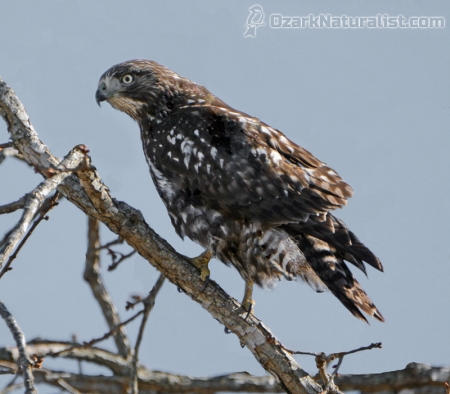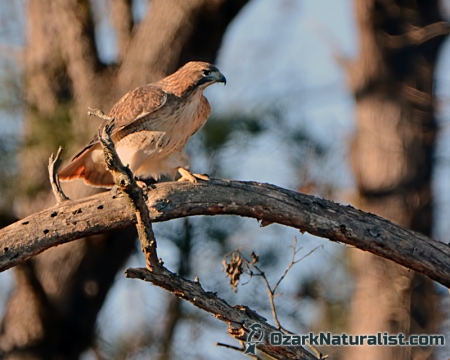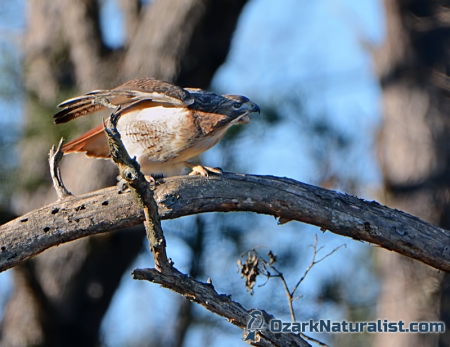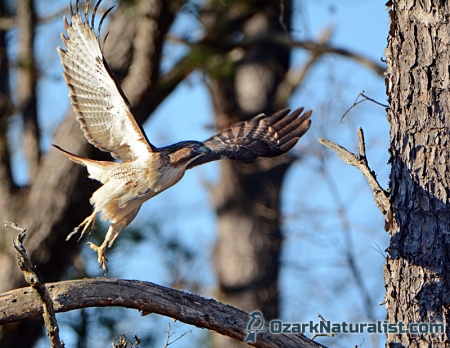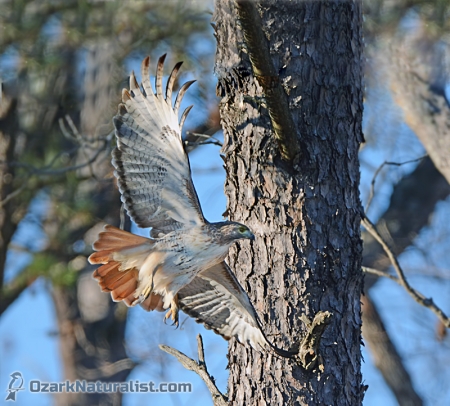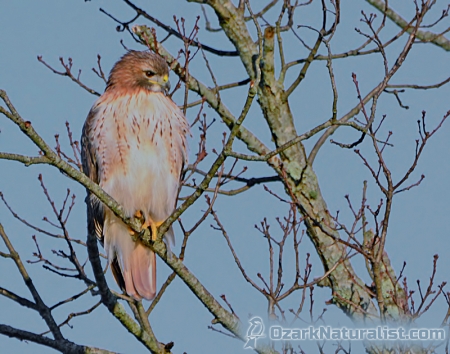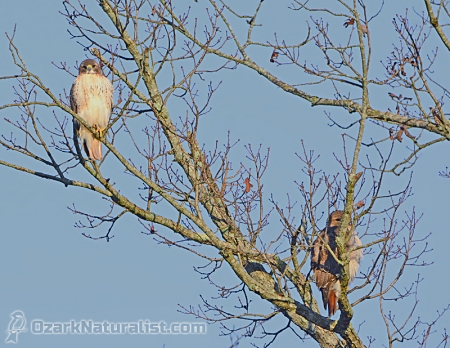To say that Red-tailed Hawks (Buteo jamaicensis) are variable in appearance is an extreme understatement. There are at least 14 recognized subspecies and even more color morphs within those subspecies. According to Raptors of Western North America by Brian K Wheeler, southern Missouri is home to the following Red-tailed varieties during the winter months:
- Eastern (B. j. borealis)
- Krider’s (Pale morph)
- Western (B. j. calurus)
- Light morph
- Light Intermediate (Rufous) morph
- Intermediate (Rufous) morph
- Dark Intermediate (Rufous) morph
- Dark morph
- Harlan’s (B. j. harlani)
- Light morph
- Light Intermediate morph
- Intermediate morph
- Dark Intermediate morph
- Dark morph
- Eastern x Western cross
- Western x Harlan’s cross
See what I mean? A variety of variety. Most of our birds are of the Eastern form, but this time of year you’re liable to encounter any of the above color morphs on any given day. Over the past two days I’ve seen a bunch of Red-tailed Hawks, at least 30 of them, and managed to photograph at least a few of them. Some of these photos are of decent quality, others not so much, but they’re good enough to illustrate what I want to show.
Let’s get started. Friday morning, on my way back from the doctor’s office, I spotted a pair of Red-tails in a tree on the opposite side of the road just east of Fremont. I started to pull off on the shoulder to take a look before crossing over to the west-bound lane and turning to approach them from the other direction, closer to them on their side of the road. But as I pulled off the road, I noticed another Red-tail on the right-of-way right next to where I was putting the truck. I knew if I stopped here, this new hawk would almost certainly be gone before I would have a chance to photograph him, or probably even get a good look, so I quickly pulled the truck back on the road and kept going. Thankfully, there were no state troopers watching my driving shenanigans.
I drove the 1/2 mile to the next crossover and turned back to the west. I pulled off here to look at the first pair I’d spotted, but they were so far across the field I didn’t bother photographing them.
I drove on to where I could get back to the other lane and went to see if the third bird was still hanging around. Surprisingly, he was still sitting in the same spot I’d seen him before. Not wanting to spook him, I pulled the truck onto the right-of-way a good distance away, perpendicular to the highway so that I could shoot out the driver’s window. He stayed put, so I backed out of the right-of-way and back onto the shoulder and slowly closed the distance. He actually let me pull along side of him, shut the truck off and shoot twenty photos before he started acting like a Red-tail and flew off.
I really like this photo, even with the limbs crossing his body and I would have been tickled if I hadn’t gotten any others. After he flew, I pulled back onto the road and planned to continue to the house. But I noticed the other pair was still hanging around, I couldn’t tell if they were in the same spot as before or if maybe they had moved closer. So I turned around and headed back once again. They had indeed moved closer to the road, though not close enough. Both birds were still in a single tree, albeit a different one and figured I might as well shoot a few shots for documentation despite the still considerable distance.
The bird facing us looks very light-colored, with little or no belly band present. But, it was catching the direct sunlight and my camera blew out the white and hid the belly markings. I could zoom in on the original photo and by really darkening the highlights, see that there were “normal” belly markings present. I’m pretty sure that this bird is a B. j. borealis, or Eastern form. We can’t see the other bird’s belly markings, but the back and tail coloration matches Wheeler’s photos of the Eastern form as well.
As I headed on to the crossover for one last turn-around, I noticed that hawk #3 was back in nearly the same spot as before, but sitting on a fence post this time. Since he hadn’t been spooky at all and I already had what I was sure were good photos, I simply pulled up beside him so that I could shoot out the passenger window again.
He sat there and let me shoot another twenty photos before taking flight. But I think I know why he was so tame. Look at that pale iris and the barred, light-colored tail. Those mark him as a juvenile, so he just hasn’t learned to be wary yet. The belly band is well-defined, but not to the point that I’d call him a Western form. Combine that with the white in the back feathers and I’d have to call him an Eastern form as well.
I was getting dizzy from all the circling about and when I pulled back on the road again, I kept going and returned home. But we were soon back on the road, headed west to Birch Tree so that Dayna could go to the yarn shop. She has a bit of a yarn problem I’m afraid. As we passed through Winona, I spotted a hawk in someone’s yard, on the other side of the road of course. He was close to the road and the turn-around was right in front of us, so we were on the hunt. This process is much easier with two people, let me tell you.
Dayna pulled off on the shoulder, almost even with him and I got a series of shots similar to this one.
Oh, that’s a dark bird. My first though was to wonder if it was even a Red-tail. Rough-legged Hawk, maybe? I always hope for something different. The bird was getting antsy, flew a short distance and we followed and I got this shot.
This photo rules out a Rough-legged—their legs are feathered right down to the toes and this bird clearly has no feathers on his legs. But, man, is he a dark bird. Back to Wheeler’s.
I cannot recommend this book enough. Published in 2003, it is now sadly out-of-print. I paid $70 for my copy and it’s well worth every penny. It has over 80 photos of just Red-tails, plus all the other species and Missouri is the eastern edge of the area covered. If you can find a copy, grab it. After flipping back-and-forth through the Red-tailed photos, looking at them again and again, I believe this to be a Harlan’s Hawk (B. j. harlani), either intermediate or dark intermediate form. It’s also another juvenile—did you notice the pale iris?
We continued on, stopping at the yarn shop, then on to Mountain View for lunch before heading home. Along the way, we “worked” several other birds without getting anything, but as we passed back though Winona, I shot this sequence of photos:
This is another Eastern form bird and I really like that last shot, the money shot, though I wish he had been a bit closer.
That was all for Friday, but early yesterday morning, about 10 miles east of Ellsinore, we worked these birds:
Yet another pair of Eastern form birds and the photos aren’t good enough that I would have normally posted them. But, this is the second time in two days I’ve seen two Red-tails in the same tree. Red-tails are monogamous with pairs mating for many years and I was going to say that they are solitary birds outside the breeding season, not tolerating the presence of other birds on their territory. They don’t start breeding until March and I thought that December was pretty early for them to be hanging out together. But I’ve found a couple of references that indicate that at least some pairs maintain contact throughout the year. In light of this new-to-me information, I guess seeing pairs together in December isn’t as unusual as I had believed.
Now I have to wonder how many Red-tailed pairs stay together year-round. Some Red-tails are migratory, so I think we can rule out these birds. But what about the sedentary birds, do all of them stay paired or do some of them split up outside the breeding season? Looks like I have more reading to do…
